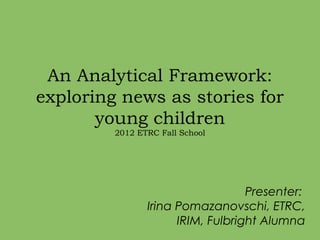
What is news part 3
- 1. An Analytical Framework: exploring news as stories for young children 2012 ETRC Fall School Presenter: Irina Pomazanovschi, ETRC, IRIM, Fulbright Alumna
- 2. Discussion: • What is a story? • What kind of themes and characters do you find in stories? • How does the point of view of the person or character telling the story affect us? • What is possible problem when we get only one person’s point of view? • What is news? • Where do we get news from? • How is the news like a story? How is it different? – Venn diagram
- 3. Three Little Pigs • Recount the story of the Three Little Pigs. • Who is /are the bad guy(s) in the story? How do you know?
- 4. Wolves: facts or opinions? 1. Wolves are sly and mean. Opinion 2. Wolves live in packs or families. Fact 3. Wolves are carnivores. 4. Wolves have supernatural powers. 5. Wolves are always hungry. 6. Wolves can dig with their paws. 7. Wolves are very clever. 8. Wolves have a 9 week gestation period.
- 5. Fast Breaking News Story
- 6. Reading: Read wolf’s version of the story.
- 7. What is BIAS? • Noun: • an attitude that you have that makes you treat someone in a way that is unfair or different from the way you treat other people • a special interest or ability in a particular thing, or a particular tendency
- 8. New you see me, now you don’t Given the what you can see of the picture above ... • What do you think these boys are doing? • Do you think your concept of what is going on in this picture would change if you could see all of it? If so, why? If not, why? • How can you relate this exercise to the idea of Bias in general?
- 9. Given what you see now ... • What do you think happened to these boys? Why? • Who do you think these boys are? Why? • How did your perception of this picture change now that you can fully see it? • How can you relate this exercise to the idea of Image Bias?
- 10. the most common ways that bias manifests itself • in the news are through word choice, omissions, the limiting of debate, framing of the story, and a biased selection and use of sources.
- 11. Questions?
Hinweis der Redaktion
- Common to find young children being asked to retell the story from the perspective of another character-introduction to critical thinking and viewing skills
- http://www.youtube.com/watch?v=6TemExNuY2Q
- bias Law (En-Ru) 1) пристрастность , предубеждение 2) заинтересованность в исходе дела 3) дискриминация 4) оказывать влияние, давление
